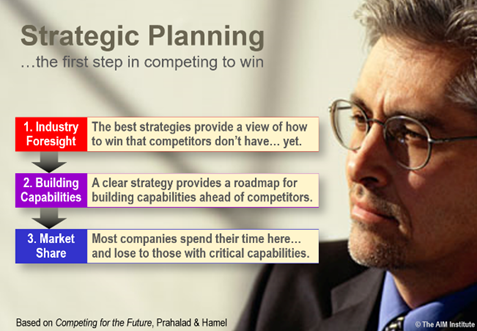Principles of good strategy... and concentrating on key market segments.
Some people think of strategic planning as a necessary annual “ritual” they need to get through. A series of presentations, templates and financial predictions. But this misses the point entirely. Proper strategic planning is how you compete for the future. (See Competing for the Future, by Prahalad and Hamel.)
There are three sequential phases of competition: First, you compete for industry foresight. This is the essence of strategic planning… where your business creates a shared view of what the future will look like… and how you can win in that future.

A great way to build this industry foresight is by considering future scenarios... "what might be"... with your business team. The AIM Institute has created a collection of future trend sheets you can download for free at www.futurescenes.com. These 16 sheets cover areas e.g. 3D printing, internet of things, autonomous vehicles, nanotechnology, and aging populations.
In the second phase, your business builds the necessary capabilities to win in the future it envisions. Your strategic plan provides the roadmap for this capability building. Here are some examples:
- Which global regions require added investment?
- What upgrades are needed in functional capabilities, e.g. marketing, R&D and sales?
- What changes are needed in operational capacity and capabilities?
The third phase is the one we’re all familiar with: competing for market share day in and day out. But it’s too late to start here. Imagine this: Company A has moved through all three phases… industry foresight, building capabilities and now is competing for market share. And Company B just “shows up” to compete for market share. It’s clear who the winner and loser will be, right?
As you conduct your strategic planning, consider these additional points:
- Strategy is a management team function. Your entire leadership team needs to have a shared view of where it’s going and how it will get there.
- Operational effectiveness doesn’t equal strategy. Just getting better at what you’re already doing isn’t strategy. If you and your competitors just keep doing the same thing better, you’re all in a race to the bottom.
- Good strategy demands trade-offs. At the end of your strategic planning, ask what you will do less If you can’t think of anything, you’ve probably wasted time in your strategic planning.
- Pull to the future, don’t push from the past. A good strategic planning process has three steps: a) Where are we now? b) Where are we going? C) How will we get there? The key is to begin with an energizing view of where you will be… and then pull yourself toward this. Write a story that hasn’t yet happened. Then live it!
Concentrate on key market segments. In our research, one of the top three growth drivers that separates the winners from losers is market concentration. This is market segmentation followed by a disproportionate focus on the most important markets.
For ideas on future trends to watch for, see The AIM Institute's FutureScenes... 2-page (free) overviews of key trends that could impact your business. Also check out the 2-minute video, Study your industry’s future, part of the B2B Organic Growth video series by Dan Adams.
Keywords: strategy, strategic planning, competing for the future, market segments, market concentration

